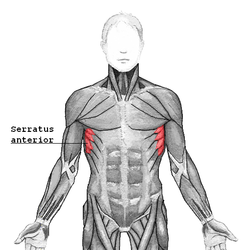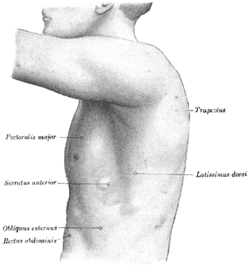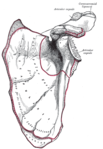|
Serratus anterior muscle
The serratus anterior is a muscle of the chest. It originates at the side of the chest from the upper 8 or 9 ribs; it inserts along the entire length of the anterior aspect of the medial border of the scapula. It is innervated by the long thoracic nerve from the brachial plexus. The serratus anterior acts to pull the scapula forward around the thorax. The muscle is named from Latin: serrare = to saw (referring to the shape); and anterior = on the front side of the body. StructureOriginSerratus anterior normally originates by nine or ten muscle slips – arising from either the 1st to 8th ribs, or the 1st to 9th ribs; because two slips usually arise from the 2nd rib, the number of slips is greater than the number of ribs from which they originate.[1] InsertionThe muscle is inserted along the medial border of the scapula between the superior and inferior angle of the scapula. The muscle is divided into three parts according to the points of insertion:[1]
InnervationThe serratus anterior is innervated by the long thoracic nerve, a branch of the brachial plexus.[2] The long thoracic nerve travels inferiorly on the surface of the serratus anterior muscle. RelationsThe serratus anterior lies deep to the subscapularis, from which it is separated by the subscapularis (supraserratus) bursa.[3] It is separated from the rib by the scapulothoracic (infraserratus) bursa.[4] FunctionAll three parts described above pull the scapula forward around the thorax, which is essential for anteversion of the arm. As such, the muscle is an antagonist to the rhomboids. However, when the inferior and superior parts act together, they keep the scapula pressed against the thorax together with the rhomboids and therefore these parts also act as synergists to the rhomboids. The inferior part can pull the lower end of the scapula laterally and forward and thus rotates the scapula to make elevation of the arm possible. Additionally, all three parts can lift the ribs when the shoulder girdle is fixed, and thus assist in respiration.[1] The serratus anterior is occasionally called the "big swing muscle" or "boxer's muscle"[5] because it is largely responsible for the protraction of the scapula — that is, the pulling of the scapula forward and around the rib cage that occurs when someone throws a punch. The serratus anterior acts in concert with the upper and lower fibers of the trapezius muscle to sustain upward rotation of the scapula, which allows for overhead lifting. Clinical significanceThe long thoracic nerve that supplies the serratus anterior muscle is vulnerable during certain types of surgery (for example, during lymph node clearance from the axilla for breast cancer). Damage to this nerve is the most common cause of winged scapula.[6] Other animalsThe muscles of the shoulder can be categorized into three topographic units: the scapulohumeral, axiohumeral, and axioscapular groups. Serratus anterior forms part of the latter group together with rhomboid major, rhomboid minor, levator scapulae, and trapezius. The trapezius evolved separately, but the other three muscles in this group evolved from the first eight or ten ribs and the transverse processes of the cervical vertebrae (homologous to the ribs).[7] Functional demands have resulted in the evolution of individual muscles from the basal unit formed by the serratus anterior. In primitive life forms, the main function of the axioscapular group is to control the movements of the vertebral border of the scapula: fibers concerned with the dorsal movement of scapula evolved into the rhomboids, those with ventral motion into serratus anterior, and those with cranial movements into levator scapulae. The evolution of the serratus anterior itself has resulted in (1) grouping of its distal and proximal fibers, (2) size reduction of its intermediate fibers, and (3) the insertion of its dominant superior and inferior parts onto the superior and inferior angles of the scapula.[7] In primates, the thoracic cage is wide and the scapula is rotated onto its posterior side to have the glenoid cavity face laterally. Additionally, the clavicle takes care of medial forces. In cursorial mammals (for example the horse and other quadrupeds), the scapula is hanging vertically on the side of the thorax and the clavicle is absent. Therefore, in climbing animals, the serratus anterior supports the scapula against the reaction forces of the free limb and exerts high bending forces on the ribs. To sustain these forces, the ribs have a pronounced curvature and are supported by the clavicle. In cursorial animals, the thorax is hanging between the scapulae at the serratus anterior and pectoralis muscles.[8] Additional images
See also
Notes
References
External linksWikimedia Commons has media related to Serratus anterior muscles.
|
||||||||||||||||||||||||||||||||||








